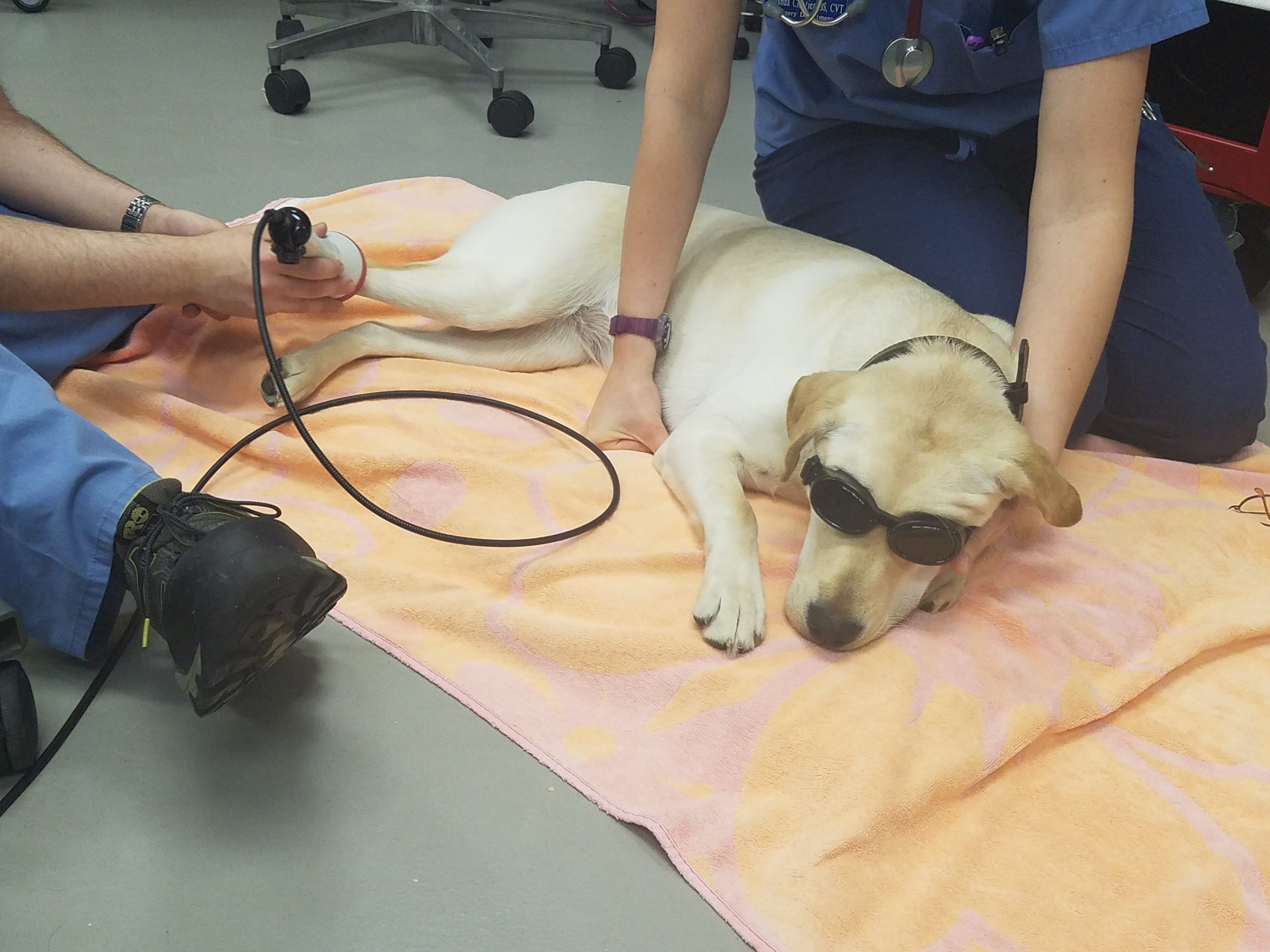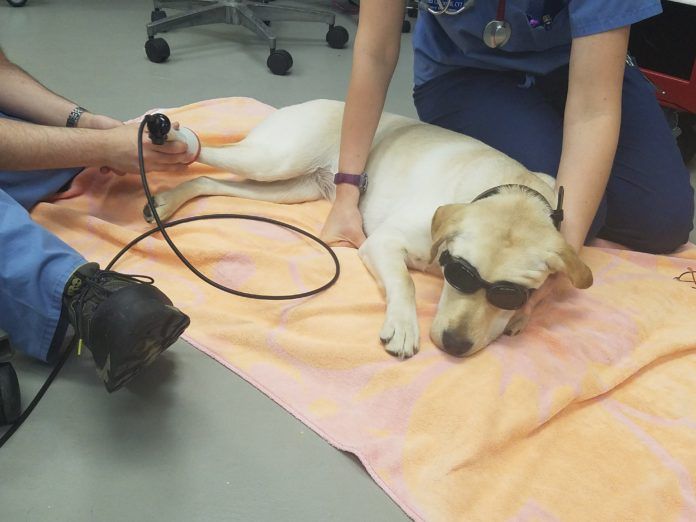
Dogs, like people, experience all kinds of pain because of conditions that range from arthritis to neurological disorders, and their owners want to do what they can to relieve their discomfort, and sometimes out-and-out suffering. Can laser therapy help? The answer is not a straightforward “yes” or “no.” For some perspective on the matter, we spoke with Alicia Karas, DVM, who runs the Pain Clinic at Tufts’ Foster Hospital for Small Animals; teaches pain medicine to veterinary students; and has cofounded Tufts’ Patient-Centered Care Initiative to forge news ways of reducing the pain of dogs (and other animals) during a visit to the hospital or throughout a hospital stay.
Your Dog: What, exactly, is laser therapy?
Dr. Karas: I can’t say I understand the physics of it, but think of it as a beam that you focus on an affected area. Different lasers have different levels of power and different wavelengths to accomplish different things. For instance, what is known as a cutting laser can literally be aimed at a spot to surgically cut or remove tissue. So in that instance, a doctor might cut a growth out of an airway that has been obstructing normal breathing. You focus the beam of the laser right on the spot, making a focal point to get the job done. It’s not really cutting so much as obliterating. It’s very powerful, sort of Star Wars-like. Low-level lasers to treat pain are different from cutting lasers, specifically not as powerful as cutting lasers, but they’re still more powerful than, say, a laser pointer. After all, they physically have to have the power to get penetration to the tissue that’s causing the problem. If you want to laser a muscle or tendon that’s causing pain, you might have to get something that can deliver the energy of the laser several inches deep. The more powerful the laser, the less time you need to spend treating and the more effective the treatment is probably going to be.
Your Dog: That sounds pretty powerful.
Dr. Karas: Think of it this way. Low-level lasers come in four classes: 1, 2, 3, and 4. Most of those used in veterinary medicine are class 3 or 4. Once you get to that level, you have to wear protective goggles or glasses, and so does the dog. If you do something like shine the laser in an eye, you can damage the eye.
Your Dog: We’re happy to stay away from physics, but can you give an indication of how training a laser on a spot could reduce pain?
Dr. Karas: It’s believed it increases circulation and helps molecules that heal move into affected tissues. In lab animal models, lasers have been shown clearly to expedite wound repair. The thinking is that laser therapy induces a photochemical reaction in cells, increasing production of substances at the molecular level that bring more oxygen to tissues, reduce inflammation, and so on. It may also be able to relax muscle tissue.
Your Dog: So are those the main things laser therapy does — reduce inflammation and relax muscle tissue?
Dr. Karas: Those are among the main things. In veterinary practice, the three main conditions low-level laser therapy is used for are to reduce inflammation and edema [fluid build-up that can decrease mobility and add to pain], promote wound healing, and treat neurological disorders and pain, including musculoskeletal defects. In humans, the range of clinical applications is much wider. It’s everything from dental to dermatological, rheumatological, and physiotherapeutic.
Your Dog: Is laser therapy for dogs really more of something on the horizon, or is it out there right now, and if so, to what degree?
Dr. Karas: Laser therapy is very commonly found in veterinary practices these days.
Your Dog: Oh, so it’s already part of mainstream pain treatment?
Dr. Karas: “Mainstream” would be overstating the case, and therein lies a telling paradox. While more and more veterinarians’ offices offer laser therapy, its use remains controversial. One problem is that the mechanisms by which it produces effects are poorly understood, not just by me but by the veterinary research community at large. We know it exposes cells, or tissue, to low levels of red and near infrared light and that that exerts some kind of effect, but despite the talk of increased oxygenation of cells and other influences, it can’t be said with confidence what is actually happening that would reduce pain. In addition, because there are so many factors in researching laser therapy — wavelength, power, and timing, to name a few — it’s hard to gauge and then document effects in scientific studies. Indeed, less than the optimal dose is useless (although a low dose may be optimal for, say, laser to promote hair regrowth), while too much can cause harm.
Your Dog: With all that uncertainty, why are more and more veterinarians’ offices carrying laser therapy equipment?
Dr. Karas: That’s a key question — with a key answer. Lasers are very heavily marketed to veterinarians. There will be two to three laser companies, at least, at every big conference. And there are big, full-page ads in veterinary magazines. But it’s all testimonials. There’s no scientific evidence that has been reviewed at arm’s length by veterinary researchers and then published in a true scientific journal. Some suggestive preliminary research, yes. But not: we divided 48 lame dogs into two groups and found that those treated with x level of laser therapy directed at a specific spot on the body for y amount of time reduced pain from z condition 37 percent more than in dogs treated with a laser wand that was not plugged in. So there’s a lot of hype, spurred by commerce.
Your Dog: So you don’t use it in your practice, then?
Dr. Karas: Actually, I do.
Your Dog: But without the scientific evidence, why?
Dr. Karas: That’s an entirely reasonable question. Let’s say we see a patient for lameness, and there’s nothing we can address surgically and we’ve given the dogs medications — NSAIDS and other pain relievers — and still he’s suffering and you’d like to be able to do something else. I maintain that a lot of pain can be at least partially resolved, and sometimes even cured, by physical means: muscle therapy, adjusting things, and pressuring things in the body to actually cause healing. To me, that’s one of the attractions of laser. I think there’s no question that it does something. And while I don’t have the tried-and-true scientific proof of a double-blind controlled study with a laser treatment group and a placebo group, I’ve seen it work. I have the clinical evidence, the anecdotal experience.
Your Dog: How so?
Dr. Karas: I’ve seen dogs with lick granulomas — awful-looking spots on their skin that have been worn away by the dog’s constant licking, perhaps because of an allergy or some other discomforting thing. The dog will have had it for a year. We apply laser therapy by beaming the spot, and in four weeks it clears up, and the dog stops licking to try to heal it. I’ve also seen improvements in inflamed tendons or arthritic joints or spasming muscles with laser therapy. Why, specifically, I cannot tell you. When laser therapy is used on people, there’s the same lack of information on how or why it might work. Mysteriously, the body has ways to resolve injury, and I think laser may be one of those ways. In alternative medicine we say, ‘the body wants to heal. We just need to figure out how to let it.’
Your Dog: But couldn’t it be dangerous to try an unproven therapy on a dog? Might it not have untoward effects so that it ends up perhaps not being useless but actually harmful?
Dr. Karas: Another good question. Healthy skepticism is really necessary here. What I say is that first, you have to exhaust all the proven possibilities — medications, surgeries, and so on. Along with that, of course, comes a proper diagnosis of the problem. You have to know what you’re dealing with so that, in fact, you don’t end up doing harm. You can’t just apply laser therapy for pain willy nilly.
Your Dog: How could it do harm, other than by burning a spot or causing eye damage, which you control by using low settings and goggles?
Dr. Karas: Well, we suspect that laser therapy increases circulation and even brings in cells to a particular area to regenerate damaged tissue. If a dog has a tumor, or maybe even an infection, there’s a good chance you don’t want to be bringing in new cells to the affected area. That could make the problem worse. Also, a tumor needs surgery, and perhaps chemotherapy or radiation. An infection needs medication such as antibiotics. If you go lasering a spot without diagnosing and applying therapies that have been scientifically proven to work, you’re wasting time and letting the problem worsen unnecessarily. This is why you need a proper diagnosis up front and an application of what veterinarians have in their healing arsenal that is known to work, not just believed to work. If you do all that work up front, however, and exhaust all proven possibilities and still the animal is in pain or uncured, that puts laser therapy in a can’t hurt-might-help position. You now at least have a savvy assessment of what it is you want to laser that nothing else has fixed — muscle, tendon, both, both plus bone, and so on.
Your Dog: How do you decide how much laser therapy to apply to a particular problem, and for how long?
Dr. Karas: The laser I use — it asks, is the dog fat or trim, what color skin does it have because dark skin absorbs more of the beam — and then you adjust the settings according to the manufacturer’s directions and control the time you apply the treatment. Again, those directions are not based on scientific evidence. They just have a good idea of what it takes to reach a certain depth in the tissue.
Your Dog: So that’s it? The vet is completely depending on the manufacturer, who has a vested interest?
Dr. Karas: It’s not quite as out-on-a-limb as that. While we can’t say for certain what level of laser helps at what time interval, laser safety can be learned by veterinarians — and is. For instance, we know that a class 4 laser can really heat up tissue. You can’t keep the probe still in one spot for too long because the area will burn. Vets can also go to a canine rehabilitation class for some specific training. It goes back to the “can’t hurt” part of can’t-hurt-might-help.
To make it all a little more confusing still, in some cases, you may assume it’s laser therapy that’s helping, but it may be the placebo effect. Forty to 50 percent of dogs experience an improvement in lameness with a placebo treatment, at least according to owner perceptions. Owners may feel they did something for their dog, they spent money; therefore, the dog feels better. At the same time, some dog health insurance companies are now reimbursing for laser treatments, which strongly suggests they don’t believe it’s a sham therapy. At the end of the day, you can reasonably choose to give it a try or not give it a try. With time, more definitive answers will come to light.





